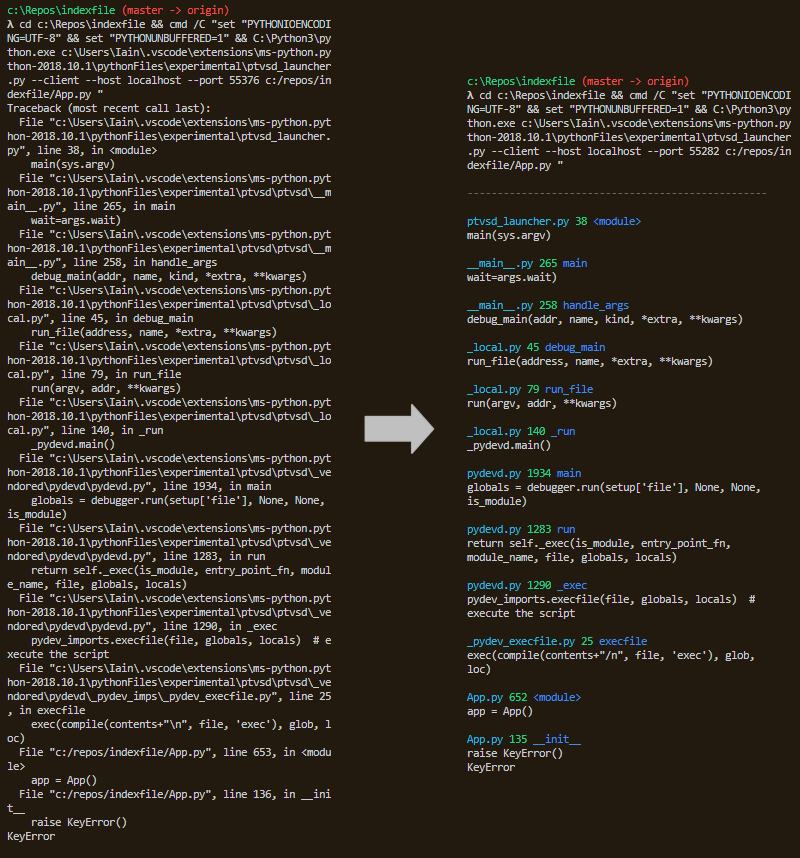Prettifies Python exception output to make it legible.
Project description
pretty-errors
Prettifies Python exception output to make it legible. Install it with
python -m pip install pretty-errors
Use it simply by importing it:
import pretty_errors
Note you need to be running in a terminal capable of colour output in order to get colour output: in Windows this means powershell, cmder, etc.
If you want to configure the output then use pretty_errors.configure(). For example:
import pretty_errors
pretty_errors.configure(
seperator_character = '—',
line_length = 54,
filename_display = pretty_errors.FILENAME_FULL
)
It is possible to have the interactive interpreter always use pretty_errors, instead of including it in your projects, by using the PYTHONSTARTUP environment variable. Set it to a python file and that file will be run every time python is. If you don't already have one then create a file with the above code block and set PYTHONSTARTUP to its path. Whenever you run python interactively, pretty_errors will be automatically imported and configured (though this will not be true when your python code is run outwith the interactive interpreter.)
Configuration settings:
-
line_length
Output will be wrapped at this point. If this matches your console width you may want to disablefull_line_newlinein order to prevent apparent double newlines. -
full_line_newline
Insert a hard newline even if the line is full. Disable if the console automatically inserts its own newline at this point. -
filename_display
How the filename is displayed: may bepretty_errors.FILENAME_COMPACT,pretty_errors.FILENAME_EXTENDED, orpretty_errors.FILENAME_FULL -
display_timestamp
When enabled a timestamp is written in the traceback header. -
display_link
When enabled a link is written below the error location, which VSCode will allow you to click on. -
seperator_character
Character used to create the header line. Hyphen is used by default. -
header_color
Escape sequence to set header color. -
timestamp_color
Escape sequence to set timestamp color. -
default_color
Escape sequence to set default color. -
filename_color
Escape sequence to set filename color. -
line_number_color
Escape sequence to set line number color. -
function_color
Escape sequence to set function color. -
link_color
Escape sequence to set link color. -
reset_stdout
When enabled the reset escape sequence will be written to stdout as well as stderr; turn this on if your console is being left with the wrong color.
If you want to customize the output more than configure provides then you can replace the output functions
on sys.stderr after importing pretty_errors. These are:
-
write_header(self)
Is called at the start of a traceback. -
timestamp(self)
Returns a string timestamp used in the header ifdisplay_timestampis enabled. -
write_location(self, path, line_number, function)
Is called with details on the exception's location. -
write_body(self, body)
Is called with any other text sent to stderr (i.e. the code in question).bodywill never contain\n, though it may be longer than the defined maximum line length.
You may replace as many of these functions as you wish, or for maximum control of output you may replace the main method called with all stderr output:
write(self, *args)
Replacement forsys.stderr.write
You may use these helper functions to make this easier (see pretty_errors/__init__.py for examples, especially write):
-
output_text(self, text, newline = False)
Outputs text while trying to only insert 1 newline when outputing a line of maximum length.textshould be a list of strings: colour escape codes and text data. -
get_location(self, text)
Extracts location of exception. If it returnsNonethen text was not a location identifier. -
is_header(self, text)
Checks if text is the start of a traceback.
For example, to change the header:
def write_header(self):
self.output_text([self.header_color, "\nERROR!!!!!!!!!!"], newline = True)
sys.stderr.write_header = write_header
Project details
Release history Release notifications | RSS feed
Download files
Download the file for your platform. If you're not sure which to choose, learn more about installing packages.
Source Distribution
Built Distribution
Hashes for pretty_errors-1.0.10-py3-none-any.whl
| Algorithm | Hash digest | |
|---|---|---|
| SHA256 | 3f1d7604dc5d944636b9c3013451cb23581bdbb43d39e14b7654bd18e2ecf400 |
|
| MD5 | cfa76b3f49c24916c6a83c8833a83148 |
|
| BLAKE2b-256 | e188f03676ffd46ad87a4d845b55e1cee4adba73f180426ce0cf24340ec63274 |












